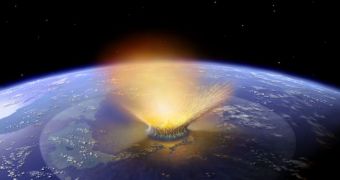According to a new research paper, published in the July 12 online issue of the top journal Science, it would appear that most of the water currently present on our planet was brought here by cosmic impacts, via asteroids and comets. This proposal has significant implications for understanding Earth.
Scientists who advocate for this theory say that the asteroids in question came from the Inner Asteroid Belt (IAB), which lies between the orbits of Mars and Jupiter. The IAB is currently home to the large asteroid/protoplanet Vesta and the dwarf planet Ceres.
Astronomers don't yet have an accurate estimate of just how many space rocks are in the Belt, but they say that many of these celestial bodies made their way to Earth in our planet's distant past, bringing whatever water they had with them.
Over the eons, as more and more of these space rocks collided into Earth, the amount of available water grew significantly. Comets that struck our world during the Late Heavy Bombardment (4.2 to 3.8 billion years ago) also brought their fair share of ice and water.
Previously, investigators believed that most of the water brought here by other celestial bodies came from the Kuiper Belt, an IAB-like structure located beyond the orbit of Neptune and Pluto. The area, together with the even-more-distant Oort Cloud, is known to house vast numbers of comets.
“Our results provide important new constraints for the origin of volatiles in the inner solar system, including the Earth. And they have important implications for the current models of the formation and orbital evolution of the planets and smaller objects in our solar system,” says Conel Alexander.
The expert, who was the lead author of the Science paper, holds an appointment as an investigator at the Carnegie Institution of Washington (CIW), Space reports. In addition to water, he says, the primitive meteorites also brought hydrogen and nitrogen to Earth, among other chemicals.
The conclusions of the new research are based on an analysis of the isotopic composition of Earth's bulk interior. Scientists discovered that it more closely resembles the chemical structure of IAB chondrite (carbon-rich) meteorites than that of Kuiper Belt comets.
According to the theory of panspermia, both water and the precursors for life came to Earth aboard space rocks of various types, over prolonged periods of time. As chance would have it, they found an excellent place to thrive here, Space reports.

 14 DAY TRIAL //
14 DAY TRIAL //